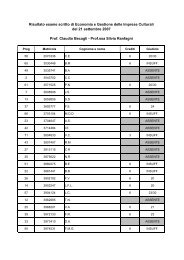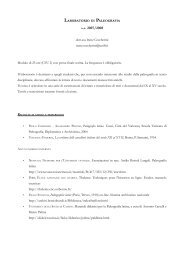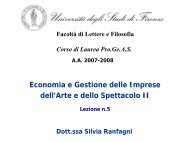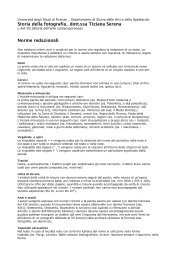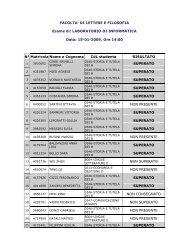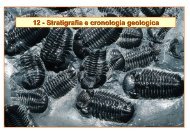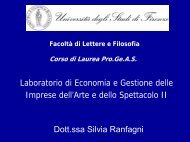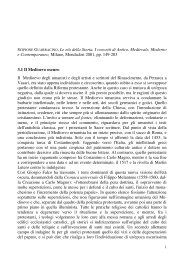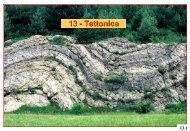Beyond Pragmatics. Morphosyntactic Development in Autism.pdf
Beyond Pragmatics. Morphosyntactic Development in Autism.pdf
Beyond Pragmatics. Morphosyntactic Development in Autism.pdf
You also want an ePaper? Increase the reach of your titles
YUMPU automatically turns print PDFs into web optimized ePapers that Google loves.
J <strong>Autism</strong> Dev Disord<br />
Jarrold, C., Boucher, J., & Russell, J. (1997). Language profiles <strong>in</strong><br />
children with autism: Theoretical and methodological<br />
implications. <strong>Autism</strong>, 1, 57–76.<br />
Kaplan, E., Fe<strong>in</strong>, D., Morris, R., & Delis, D. (1991). WAIS as a<br />
neuropsychological <strong>in</strong>strument (Manual). New York: Psychological<br />
Corporation.<br />
Kelley, E., Paul, J., Fe<strong>in</strong>, D., & Naigles, L. R. (2006). Residual<br />
language deficits <strong>in</strong> optimal outcome children with a history<br />
of autism. Journal of <strong>Autism</strong> and <strong>Development</strong>al Disorders,<br />
34(1), 87–102.<br />
Kjelgaard, M. M., & Tager-Flusberg, H. (2001). An <strong>in</strong>vestigation<br />
of language impairment <strong>in</strong> autism: Implications for genetic<br />
subgroups. Language and Cognitive Processes, 16(2/3), 287–<br />
308.<br />
Lawson, T. T., & Evans, L. D. (1996). Stanford-B<strong>in</strong>et: Fourth<br />
edition short forms with underachiev<strong>in</strong>g and learn<strong>in</strong>g disabled<br />
students. Psychological Reports, 79(1), 47–50.<br />
Lord, C., Goode, S., Heemsbergen, J., Jordan, H., Mawhood, L.,<br />
& Rutter, M. (1989). <strong>Autism</strong> diagnostic observation schedule:<br />
A standardized observation of communicative and<br />
social behavior. Journal of <strong>Autism</strong> and <strong>Development</strong>al Disorders,<br />
19, 185–212.<br />
Lord, C., & Paul, R. (1997). Language and communication <strong>in</strong><br />
autism. In D. J. Cohen & F. R. Volkmar (Eds.), Handbook<br />
of autism and pervasive developmental disorders (2nd ed.,<br />
pp. 195–225). New York: Wiley.<br />
Lord, C., & Pickles, A. (1996). Language level and nonverbal<br />
social-communicative behaviors <strong>in</strong> autistic and languagedelayed<br />
children. Journal of the Academy of Child and<br />
Adolescent Psychiatry, 35(11), 1542–1550.<br />
Lord, C., Rutter, M., & DiLavore, P. C. (1998). <strong>Autism</strong> diagnostic<br />
observation schedule-generic. Chicago, IL: University<br />
of Chicago.<br />
Lord, C., Rutter, M., & LeCouteur, A. (1994). <strong>Autism</strong> diagnostic<br />
<strong>in</strong>terview-revised: A revised version of a diagnostic <strong>in</strong>terview<br />
for caregivers of <strong>in</strong>dividuals with possible pervasive<br />
developmental disorders. Journal of <strong>Autism</strong> and <strong>Development</strong>al<br />
Disorders, 24, 659–685.<br />
MacWh<strong>in</strong>ney, B. (1991). The CHILDES Database. Dubl<strong>in</strong>, OH:<br />
Discovery Systems.<br />
MacWh<strong>in</strong>ney, B. (2000). The CHILDES project: Tools for analyz<strong>in</strong>g<br />
talk (3rd ed.). Mahwah, NJ: Lawrence Erlbaum<br />
Associates.<br />
Marcus, G., P<strong>in</strong>ker, S., Ullman, M., Hollander, M., Rosen, T., &<br />
Xu, F. (1992). Over-regularization <strong>in</strong> language acquisition.<br />
Monographs of the Society for Research <strong>in</strong> Child <strong>Development</strong>,<br />
57(4), 1–182.<br />
Mottron, L. (2004). Match<strong>in</strong>g strategies <strong>in</strong> cognitive research<br />
with <strong>in</strong>dividuals with high-function<strong>in</strong>g autism: Current<br />
practices, <strong>in</strong>strument biases, and recommendations. Journal<br />
of <strong>Autism</strong> and <strong>Development</strong>al Disorders, 34(1), 19–27.<br />
Ozonoff, S., & Miller, J. (1996). An exploration of right-hemisphere<br />
contributions to the pragmatic impairments of autism.<br />
Bra<strong>in</strong> and Language, 52(3), 411–434.<br />
Prior, M. R., & Hall, L. C. (1979). Comprehension of transitive<br />
and <strong>in</strong>transitive phrases by autistic, retarded, and normal<br />
children. Journal of Communication Disorders, 12, 103–111.<br />
Prizant, B., & Duchan, J. (1981). The functions of immediate<br />
echolalia <strong>in</strong> autistic children. Journal of Speech and Hear<strong>in</strong>g<br />
Disorder, 46, 241–249.<br />
Rap<strong>in</strong>, I. (1991). Autistic children: Diagnosis and cl<strong>in</strong>ical features.<br />
Pediatrics, 87(5), 751–760.<br />
Rap<strong>in</strong>, I., & Dunn, M. (2003). Update on the language disorders<br />
of <strong>in</strong>dividuals on the autistic spectrum. Bra<strong>in</strong> and <strong>Development</strong>,<br />
25(3), 166–172.<br />
Rub<strong>in</strong>o, R. B., & P<strong>in</strong>e, J. M. (1998). Subject-verb agreement <strong>in</strong><br />
Brazilian Portuguese: What low error rates hide. Journal of<br />
Child Language, 25(1), 35–59.<br />
Rumsey, J. M., Duara, R., Grady, C., Rapoport, J. L., Margol<strong>in</strong>,<br />
R. A., Rapoport, S. I., et al. (1985). Bra<strong>in</strong> metabolism <strong>in</strong><br />
autism: Rest<strong>in</strong>g cerebral glucose utilization rates as measured<br />
with positron emission tomography. Archives of<br />
General Psychiatry, 42(5), 448–455.<br />
Rutter, M. (1970). Autistic children: Infancy to adulthood.<br />
Sem<strong>in</strong>ars <strong>in</strong> Psychiatry, 2, 435–450.<br />
Rutter, M., Mawhood, L., & Howl<strong>in</strong>, P. (1992). Language delay<br />
and social development. In P. Fletcher & D. Hall (Eds.),<br />
Specific speech and language disorders <strong>in</strong> children: Correlates,<br />
characteristics, and outcomes (pp. 63–78). London:<br />
Whurr.<br />
Sattler, J. M. (1992). Assessment of children: Revised and updated<br />
third edition. San Diego, CA: Jerome M. Sattler, Inc.<br />
Scarborough, H. (1990). Index of productive syntax. Applied<br />
Psychol<strong>in</strong>guistics, 11, 1–22.<br />
Scarborough, H., Rescorla, L., Tager-Flusberg, H., Fowler, A., &<br />
Sudhalter, V. (1991). Relation of utterance length to grammatical<br />
complexity <strong>in</strong> normal or language-disordered<br />
groups. Applied Psychol<strong>in</strong>guistics, 12, 23–45.<br />
Seidenberg, M. S., & MacDonald, M. C. (1999). A probabilistic<br />
constra<strong>in</strong>ts approach to language acquisition and process<strong>in</strong>g.<br />
Cognitive Science, 23(4), 569–588.<br />
Shriberg, L. D., Paul, R., McSweeny, J. L., Kl<strong>in</strong>, A. M., Cohen,<br />
D. J., & Volkmar, F. R. (2001). Speech and prosody characteristics<br />
of adolescents and adults with high-function<strong>in</strong>g<br />
autism and Asperger syndrome. Journal of Speech and<br />
Language Hear<strong>in</strong>g Research, 44(5), 1097–1115.<br />
Stone, W., & Yoder, P. (2001). Predict<strong>in</strong>g spoken language level<br />
<strong>in</strong> children with autism spectrum disorders. <strong>Autism</strong>, 5(4),<br />
341–361.<br />
Szatmari, P., Bryson, S., Boyle, M., Stre<strong>in</strong>er, D., & Duku, E.<br />
(2003). Predictors of outcome among high function<strong>in</strong>g children<br />
with autism and Asperger syndrome. Journal of Child<br />
Psychology and Psychiatry, 44(4), 520–528.<br />
Tager-Flusberg, H., & Anderson, M. (1991). The development of<br />
cont<strong>in</strong>gent discourse ability <strong>in</strong> autistic children. Journal of<br />
Child Psychology and Psychiatry, 32(7), 1123–1134.<br />
Tager-Flusberg, H., & Calk<strong>in</strong>s, S. (1990). Does imitation facilitate<br />
acquisition of grammar Evidence from the study of<br />
autistic, Down’s syndrome and normal children. Journal of<br />
Child Language, 17, 591–606.<br />
Tager-Flusberg, H., Calk<strong>in</strong>s, S., Nol<strong>in</strong>, T., Baumberger, T.,<br />
Anderson, M., & Chadwick-Dias, A. (1990). A longitud<strong>in</strong>al<br />
study of language acquisition <strong>in</strong> autistic and Down syndrome<br />
children. Journal of <strong>Autism</strong> and <strong>Development</strong>al<br />
Disorders, 20(1), 1–21.<br />
Thorndike, R. L., Hagen, E. P., & Sattler, J. M. (1986). The<br />
Stanford-B<strong>in</strong>et Intelligence Scale: Fourth Edition. Chicago,<br />
IL: Riverside Publish<strong>in</strong>g.<br />
Volden, J., & Lord, C. (1991). Neologisms and idiosyncratic<br />
language <strong>in</strong> autistic speakers. Journal of <strong>Autism</strong> and<br />
<strong>Development</strong>al Disorders, 21, 109–130.<br />
Wanska, S. K., & Bedrosian, J. L. (1986). Topic and communicative<br />
<strong>in</strong>tent <strong>in</strong> mother–child discourse. Journal of Child<br />
Language, 13(3), 523–535.<br />
123


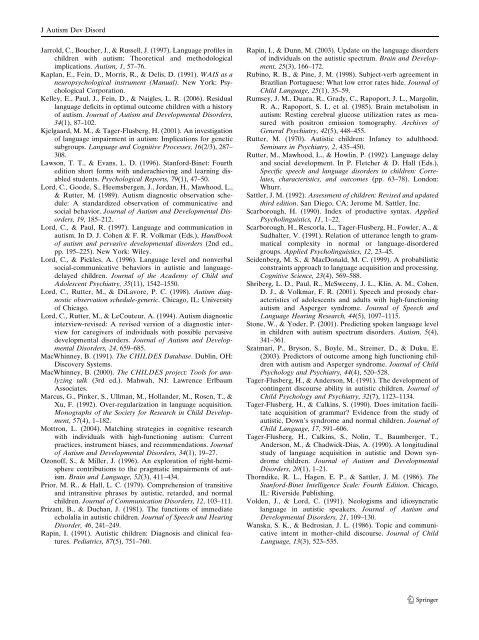
![PATROLOGIA GRECA E LATINA [Patrologiae cursus completus]. All ...](https://img.yumpu.com/50711133/1/184x260/patrologia-greca-e-latina-patrologiae-cursus-completus-all-.jpg?quality=85)
